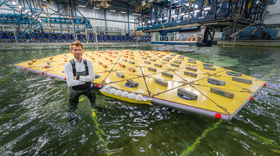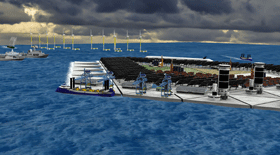Netherlands Developing Floating Mega-Island Concept
The Maritime Research Institute Netherlands (MARIN) has tested a concept for a floating mega-island. Such an island could consist of large floating triangles that are connected to each other flexibly to make a structure that could span up to five kilometers with an area of about three square kilometers. The islands would be anchored to the sea bed and also moored to the shore.
The test model, which measures roughly six by eight meters and is made of wood and polystyrene, was laid out Tuesday in a huge water tank to simulate wind, waves and storms, in a presentation for several potential investors. Discussions are underway with the local authority of crowded Haarlemmermeer and the Lelystad airport, both close to Amsterdam.


Olaf Waals, project manager and designer of the concept, says: "In a time of sea rise, overpopulated cities and an increasing number of activities at sea, raising dikes and spraying of sand may not be the most effective solution. Floating ports and cities are an innovative alternative that fits the Dutch maritime tradition."
He says, floating mega-islands offer future-proof working and living space at sea for:
* Developing, generating, storing and maintaining sustainable energy at sea (offshore wind, tidal energy, wave energy, floating solar panels);
* Coastal landing and transhipment in areas with low infrastructure
* Cultivating foods such as seaweed and fish
* Living and recreational space near the water.
The "Space at Sea" project has won about $1.8 million in European subsidies to carry out three years of research and development.
Waals admits the technological challenges are high but believes the islands could be technically feasible within 20 years. He says, researchers must answer questions such as: “how do we develop floating "mega structures" that are strong and safe in storms and currents? How are these systems connected to each other and to the seabed? How big are the movements, and what effect do they have on the people on the island? How do we organize traffic and transportation?
“But the questions are also ecological: what is the influence of this big floating community on the water underneath and around? How do we make the system completely circular in terms of water, energy, raw materials and waste?”
